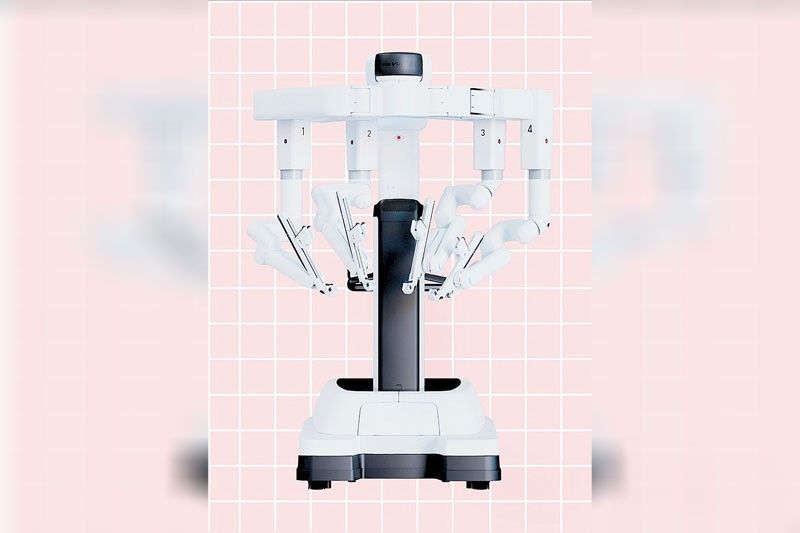
Upgrade to High-Speed Internet for only ₱1499/month!
Enjoy up to 100 Mbps fiber broadband, perfect for browsing, streaming, and gaming.
Visit Suniway.ph to learn
At MakatiMed, yes! The award-winning hospital is one of the pioneering institutions to acquire the Da Vinci Xi Robotic Surgical System, ushering in a new era of precision in surgical care.
Robots are improving our daily lives in ways we’ve never imagined. From performing mundane tasks like sweeping the floor or washing the dishes to helping paraplegics walk again, these machines are changing the game — whether at home or in the workplace.
But, would you trust a robot to save your life? Even the most enthusiastic tech geek would jump out of the hospital bed when he sees Baymax in scrubs in the operating room (OR) where lives are at stake.
Or so I thought. Until I got up-close and personal with Da Vinci, not the Italian polymath, but the robotic surgical system that’s changing the way patient care is delivered in top hospitals worldwide.
Robotics in healthcare
Using medical robots is becoming the gold standard in surgery in medical care facilities around the globe. The presence of this humongous machine — “with a heart” — is becoming increasingly prominent, enhancing overall efficiency within healthcare settings.
In the Philippines, Makati Medical Center (MakatiMed) is one of the pioneering institutions to acquire the fourth-generation Da Vinci Xi Robotic Surgical System, ushering in a new era of precision in surgical care.
MakatiMed hosted a media session recently which allowed us to take a closer look at the medical robot, named after the “Father of Anatomy.” And, aptly so. Da Vinci’s contributions to anatomy, mechanics, and automation are reflected in the system’s ability to perform complex surgeries with precision. Add to that, the robot has four hands/arms, which reminds me of Renaissance artist’s “Vitruvian Man” drawing, a symbol of the ideally proportioned human form.
“The arms are equipped with surgical instruments and cameras that a physician controls remotely from a console,” explained Allan Cabayan, RN, as he directed our attention to the console and TV monitor placed not too far from the operating bed and the Da Vinci Xi in one of MakatiMed’s operating suites.

The MakatiMed Da Vinci Xi team: (from left) Dr. Jaime SD Songco, chairman of the Dept. of Surgery, MakatiMed; Dr. Mark Augustine S. Onglao, a consultant at the Dept. of Surgery, Section of Colorectal Surgery; Arlyn L. Songco, senior VP for creative, communications, and sales services; Dr. Saturnino Javier, interim co-president and CEO, MakatiMed; Dr. Arsenio A. Cabungcal, section chief of head and neck oncology; Dr. Jennifer Marie M. Jose, section chief of urogynecology and pelvic reconstructive surgery; and Dr. Catherine S.C. Teh, section chief of hepatobiliary surgery and Liver transplantation
What you need to know about Da Vinci Xi
Da Vinci Xi is a fourth-generation, computer-assisted robotic surgery system. Meaning, it doesn’t perform the surgery on its own. Guided by what looks a lot like a virtual-reality gaming setup, the surgeon — who sits next to it in the operating room with the patient — controls the robot on a surgical console.
Besides affording them with a clearer and magnified 3D version of a patient’s internal organs, the Da Vinci Xi moves more efficiently and has a greater range of motion than the human hand. This results in more precise cuts and sutures, less bleeding and pain, and quicker recovery times.
“This technology will usher in a new era of precision,” said Dr. Saturnino P. Javier, medical director and interim co-president and CEO, MakatiMed. “Precision is a key issue that we are aiming for with this new technology. Second is the less-invasive nature of the procedure.”
Da Vinci Xi may be a humongous device, but it’s a “very gentle robot.”
“The robot has very minimal tissue manipulation which is very crucial in surgery,” noted Dr. Catherine Teh, chief of the section of hepatobiliary surgery and liver transplantation, during the roundtable discussion.
What the medical experts say
Acquired by MakatiMed in May 2024, the Da Vinci Xi has been used in various surgical procedures, particularly in the fields of obstetrics and gynecology, urology, hepatobiliary surgery, and liver transplantation, colorectal surgery, and otorhinolaryngology (head, throat, and neck).
Board-certified, robotics-trained Filipino surgeons from these specializations explained the versatility, as well as the advantages of robotic surgery, to both patients and doctors.
Dr. Jaime Songco, urologic cardiologist and chairman of MakatiMed’s Department of Surgery, was the first to use the Da Vinci Xi for prostate surgery.
Urologists treat patients with kidney, ureter, bladder and prostate problems.Compared to women (who are designed for childbirth), men’s pelvic area is smaller in diameter. So, if a patient has prostate cancer, the surgeon needs to go way down below, very near the colorectal area, just to visualize its structure.
“Say, for example, if the tumor is like a castañas (in size), in robotic surgery, it’s like a chico. The image is magnified 12 times,” noted Dr. Songco. “It’s also three-dimensional, so you can avoid more damage to nearby organs. There’s also nerve sparing, improved continence and erectile function, and less blood loss, all of which make for a shorter hospital stay.”
Dr. Jennifer Marie Jose, obstetrician-gynecologist and section chief of Urogynecology and Pelvic Reconstructive Surgery, has performed hundreds of robotic surgeries with Da Vinci Xi — from hysterectomies and myomectomies to endometriosis resection and incontinence procedures.
“Using Da Vinci Xi is like doing an open surgery in a minimally invasive manner because there is less manipulation of tissues,” shared Dr. Jose, who is also a board member of the Asian Society of Gynecologic Robotic Surgery.
Robot-assisted surgeries only create small incisions that can also help reduce the chance of postoperative complications, which are a common concern among women who often juggle multiple responsibilities.
“This robotic surgery system gives surgeons like us seven degrees of freedom, providing us with adequate vision, precision, dexterity and control,” explained Dr. Jose, who incidentally is an international proctor of the Da Vinci surgical system in Asian countries.
Another complicated surgery to perform is rectal surgery to address colorectal cancer, the third most common cancer in the world and a cancer that has been diagnosed of late among individuals in their 20s and 30s.
Located deep in the pelvis and surrounded by bone, nerves, vessels, and the genital and urinary organs, it can be approached laparoscopically, with the use of long instruments.
“Laparoscopy is like operating with chopsticks, but with robotic surgery, it’s like your hand is inside the patient,” shared Dr. Mark Augustine S. Onglao, consultant at the Department of Surgery Section of Colorectal Surgery, and the skills and technical coordinator of the Training Committee of the Department of Surgery. “In robotic surgery, you become a four-armed surgeon, with all four arms of the robot under your direct control.
Why are we so hell-bent on precision and dexterity? Because we believe, especially for cancer, better surgery leads to better outcomes.”

The surgical robot is in: The Da Vinci Xi is a fourth-generation, computer-assisted robotic surgery system.
“In gynecology, we have the perimenopausal, the menopausal, and the reproductive age groups. All of these women benefit from this kind of procedure,” Dr. Jose added.
Before the Da Vinci Xi, tumors in the mouth were reached through big incisions made on the patients’ neck, thus affecting how they swallowed and exposing them to possible infections.
“Now, we can offer our patients transoral robotic surgery, by going through natural openings in the head and neck to do surgeries and resections of tumors in the upper airway, particularly the throat,” said Dr. Arsenio A. Cabungcal, consultant at the Department of Otorhinolaryngology, Head and Neck Surgery, and section chief of the Head and Neck Surgery. “Patients are able to eat and swallow better after the surgery because we’re more precise with the dissections. And that results in less pain and faster recovery time.”
Surgeries for the liver, gallbladder, bile ducts, pancreas, duodenum, and spleen are tricky because these organs are not only found in the chest area, they are also under the rib cage, making it necessary to pry a patient open.
While laparoscopic surgery has done away with the need to cut a patient up, the minimally invasive approach, which inserts thin rod-like instruments with a light source and camera into tiny incisions made on the patient’s body, still has its limitations.
“If I perform a laparoscopic liver resection, a patient will have to stay in the hospital for three to seven days. If I perform a robotic liver resection, a patient stays for only one to five days.And in one to two weeks time, he or she is already traveling,” enthused Dr. Catherine SC. Teh, who specializes in hepatopancreatobiliary (HPB) surgery and is the first female and second Filipino surgeon conferred with the Honorary Fellow of the American College of Surgeons.
Da Vinci Xi’s powerful zoom-in feature, dexterous arms, and stable high-definition camera benefit this surgeon, too. Teh, who has performed over 1,000 liver resections in her career (600 of them open, 400 laparoscopic), can now do back-to-back liver resections using robotic surgery.
“Robotic surgery makes the impossible look possible, and the difficult look beautiful,” shared Dr. Teh, section chief of MakatiMed’s hepatobiliary surgery and liver transplantation.
Still, the question remains: How much does robotic surgery cost?
“The cost of a robot-assisted surgery is quite expensive compared to open surgery and laparoscopy,” noted MakatiMed interim co-president and CEO Dr. Saturnino Javier. “But what you need to realize is that health is something we can’t put a price tag on. You have to factor several things as well, like how soon can the patient go back to work? The phase of recovery. So whatever that patient spent on robotics will be recovered because of the easily gained productivity.”
The gold standard
MakatiMed, which performs multiple robotic surgeries a month, is set to do more, offering training programs to its surgeons. Some are currently training to operate on the heart and other organs in the thorax. After all, the enhanced precision, visibility, dexterity, and ergonomic design of the Da Vinci Xi console can help prolong the careers of surgeons — yes, even Dr. Romantic (Han Suk-kyu) — by reducing natural hand tremors and physical strain, especially during long, complex procedures.
While traditional and laparoscopic surgeries will continue to have a place in the Philippines, MakatiMed hopes robotic surgery offers patients another option, especially as many tend to delay consults and treatments due to the fear of invasive procedures, prolonged recovery times, and potential complications.
“We will always have patients who need open surgeries and minimally invasive surgeries,” said Dr. Songco. “The Da Vinci Xi platform is designed for open surgeons to navigate towards the robotic pathway. As my colleagues have mentioned, you have to be a good open surgeon before becoming a good robotic surgeon.”
So, would you trust a robot to save your life?
“There are two things that are very important to men: continence and erection. Robotic surgery can help restore both,” replied Dr. Songco with an impish grin.
* * *
For information, contact MakatiMed On-Call at 8888-8999, email mmc@makatimed.net.ph, or visit www.makatimed.net.ph.
Follow @IamMakatiMed on Facebook and Twitter.

 2 months ago
24
2 months ago
24


_2025_06_27_10_50_56.jpg)
